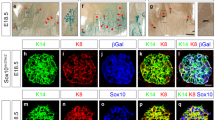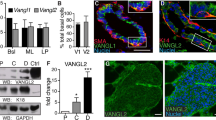Abstract
Transgenic mice expressing the Notch 4 intracellular domain (ICD) (Int3) in the mammary gland have two phenotypes: arrest of mammary alveolar/lobular development and mammary tumorigenesis. Notch4 signaling is mediated primarily through the interaction of Int3 with the transcription repressor/activator Rbpj. We have conditionally ablated the Rbpj gene in the mammary glands of mice expressing whey acidic protein (Wap)-Int3. Interestingly, Rbpj knockout mice (Wap-Cre+/Rbpj−/−/Wap-Int3) have normal mammary gland development, suggesting that the effect of endogenous Notch signaling on mammary gland development is complete by day 15 of pregnancy. RBP-J heterozygous (Wap-Cre+/Rbpj−/+/Wap-Int3) and Rbpj control (Rbpjflox/flox/Wap-Int3) mice are phenotypically the same as Wap-Int3 mice with respect to mammary gland development and tumorigenesis. In addition, the Wap-Cre+/Rbpj−/−/Wap-Int3-knockout mice also developed mammary tumors at a frequency similar to Rbpj heterozygous and Wap-Int3 control mice but with a slightly longer latency. Thus, the effect on mammary gland development is dependent on the interaction of the Notch ICD with the transcription repressor/activator Rbpj, and Notch-induced mammary tumor development is independent of this interaction.
This is a preview of subscription content, access via your institution
Access options
Subscribe to this journal
Receive 50 print issues and online access
$259.00 per year
only $5.18 per issue
Buy this article
- Purchase on Springer Link
- Instant access to full article PDF
Prices may be subject to local taxes which are calculated during checkout







Similar content being viewed by others
References
Bashyam MD . (2002). Understanding cancer metastasis: an urgent need for using differential gene expression analysis. Cancer 94: 1821–1829.
Bray S, Furriols M . (2001). Notch pathway: making sense of suppressor of hairless. Curr Biol 11: R217–R221.
Buono KD, Robinson GW, Martin C, Shi S, Stanley P, Tanigaki K et al. (2006). The canonical Notch/RBP-J signaling pathway controls the balance of cell lineages in mammary epithelium during pregnancy. Dev Biol 293: 565–580.
Callahan R, Egan SE . (2004). Notch signaling in mammary development and oncogenesis. J Mammary Gland Biol Neoplasia 9: 145–163.
Dumont E, Fuchs KP, Bommer G, Christoph B, Kremmer E, Kempkes B . (2000). Neoplastic transformation by Notch is independent of transcriptional activation by RBP-J signalling. Oncogene 19: 556–561.
Furriols M, Bray S . (2000). Dissecting the mechanisms of suppressor of hairless function. Dev Biol 227: 520–532.
Furriols M, Bray S . (2001). A model Notch response element detects Suppressor of Hairless-dependent molecular switch. Curr Biol 11: 60–64.
Gallahan D, Callahan R . (1987). Mammary tumorigenesis in feral mice: identification of a new int locus in mouse mammary tumor virus (Czech II)-induced mammary tumors. J Virol 61: 66–74.
Gallahan D, Callahan R . (1997). The mouse mammary tumor associated gene INT3 is a unique member of the NOTCH gene family (NOTCH4). Oncogene 14: 1883–1890.
Gallahan D, Jhappan C, Robinson G, Hennighausen L, Sharp R, Kordon E et al. (1996). Expression of a truncated Int3 gene in developing secretory mammary epithelium specifically retards lobular differentiation resulting in tumorigenesis. Cancer Res 56: 1775–1785.
Han H, Tanigaki K, Yamamoto N, Kuroda K, Yoshimoto M, Nakahata T et al. (2002). Inducible gene knockout of transcription factor recombination signal binding protein-J reveals its essential role in T versus B lineage decision. Int Immunol 14: 637–645.
Hu C, Dievart A, Lupien M, Calvo E, Tremblay G, Jolicoeur P . (2006). Overexpression of activated murine Notch1 and Notch3 in transgenic mice blocks mammary gland development and induces mammary tumors. Am J Pathol 168: 973–990.
Imatani A, Callahan R . (2000). Identification of a novel NOTCH-4/INT-3 RNA species encoding an activated gene product in certain human tumor cell lines. Oncogene 19: 223–231.
Jeffries S, Capobianco AJ . (2000). Neoplastic transformation by Notch requires nuclear localization. Mol Cell Biol 20: 3928–3941.
Jhappan C, Gallahan D, Stahle C, Chu E, Smith GH, Merlino G et al. (1992). Expression of an activated Notch-related int-3 transgene interferes with cell differentiation and induces neoplastic transformation in mammary and salivary glands. Genes Dev 6: 345–355.
Kato H, Sakai T, Tamura K, Minoguchi S, Shirayoshi Y, Hamada Y et al. (1996). Functional conservation of mouse Notch receptor family members. FEBS Lett 395: 221–224.
Kordon EC, Smith GH, Callahan R, Gallahan D . (1995). A novel non-mouse mammary tumor virus activation of the Int-3 gene in a spontaneous mouse mammary tumor. J Virol 69: 8066–8069.
Leong KG, Niessen K, Kulic I, Raouf A, Eaves C, Pollet I et al. (2007). Jagged1-mediated Notch activation induces epithelial-to-mesenchymal transition through Slug-induced repression of E-cadherin. J Exp Med 204: 2935–2948.
Levy OA, Lah JJ, Levey AI . (2002). Notch signaling inhibits PC12 cell neurite outgrowth via RBP-J-dependent and -independent mechanisms. Dev Neurosci 24: 79–88.
Luo D, Renault VM, Rando TA . (2005). The regulation of Notch signaling in muscle stem cell activation and postnatal myogenesis. Semin Cell Dev Biol 16: 612–622.
MacKenzie F, Duriez P, Wong F, Noseda M, Karsan A . (2004). Notch4 inhibits endothelial apoptosis via RBP-Jkappa-dependent and -independent pathways. J Biol Chem 279: 11657–11663.
Oakes SR, Hilton HN, Ormandy CJ . (2006). The alveolar switch: coordinating the proliferative cues and cell fate decisions that drive the formation of lobuloalveoli from ductal epithelium. Breast Cancer Res 8: 207.
Raafat A, Bargo S, Anver MR, Callahan R . (2004). Mammary development and tumorigenesis in mice expressing a truncated human Notch4/Int3 intracellular domain (h-Int3sh). Oncogene 23: 9401–9407.
Raafat A, Zoltan-Jones A, Strizzi L, Bargo S, Kimura K, Salomon D et al. (2007). Kit and PDGFR-alpha activities are necessary for Notch4/Int3-induced tumorigenesis. Oncogene 26: 662–672.
Robbins J, Blondel BJ, Gallahan D, Callahan R . (1992). Mouse mammary tumor gene int-3: a member of the notch gene family transforms mammary epithelial cells. J Virol 66: 2594–2599.
Shawber C, Nofziger D, Hsieh JJ, Lindsell C, Bögler O, Hayward D et al. (1996). Notch signaling inhibits muscle cell differentiation through a CBF1-independent pathway. Development 122: 3765–3773.
Shin HM, Minter LM, Cho OH, Gottipati S, Fauq AH, Golde TE et al. (2006). Notch1 augments NF-kappaB activity by facilitating its nuclear retention. EMBO J 25: 129–138.
Smith GH, Gallahan D, Diella F, Jhappan C, Merlino G, Callahan R . (1995). Constitutive expression of a truncated INT3 gene in mouse mammary epithelium impairs differentiation and functional development. Cell Growth Differ 6: 563–577.
Stylianou S, Clarke RB, Brennan K . (2006). Aberrant activation of notch signaling in human breast cancer. Cancer Res 66: 1517–1525.
Wagner KU, Wall RJ, St-Onge L, Gruss P, Wynshaw-Boris A, Garrett L et al. (1997). Cre-mediated gene deletion in the mammary gland. Nucleic Acids Res 25: 4323–4330.
Yoder BJ, Wilkinson EJ, Massoll NA . (2007). Molecular and morphologic distinctions between infiltrating ductal and lobular carcinoma of the breast. Breast J 13: 172–179.
Zheng X, Linke S, Dias JM, Gradin K, Wallis TP, Hamilton BR et al. (2008). Interaction with factor inhibiting HIF-1 defines an additional mode of cross-coupling between the Notch and hypoxia signaling pathways. Proc Natl Acad Sci USA 105: 3368–3373.
Acknowledgements
The Rbpjflox/flox mice were kindly provided by Dr Tasuku Honjo, Department of Medical Chemistry, Graduate School of Medicine, Kyoto University, Kyoto, Japan, and the WAP-Cre mice were kindly provided by Dr Lothar Hennighausen, Laboratory of Genetics and Physiology, National Institute of Diabetes and Digestive and Kidney Diseases, National Institutes of Health, Bethesda, MD, USA. This research was supported by the Intramural Research Program of the NIH, National Cancer Institute, Center for Cancer Research.
Author information
Authors and Affiliations
Corresponding author
Rights and permissions
About this article
Cite this article
Raafat, A., Lawson, S., Bargo, S. et al. Rbpj conditional knockout reveals distinct functions of Notch4/Int3 in mammary gland development and tumorigenesis. Oncogene 28, 219–230 (2009). https://doi.org/10.1038/onc.2008.379
Received:
Revised:
Accepted:
Published:
Issue Date:
DOI: https://doi.org/10.1038/onc.2008.379
Keywords
This article is cited by
-
Unique functions for Notch4 in murine embryonic lymphangiogenesis
Angiogenesis (2022)
-
Mammary Development and Breast Cancer: a Notch Perspective
Journal of Mammary Gland Biology and Neoplasia (2021)
-
The ANK repeats of Notch-4/Int3 activate NF-κB canonical pathway in the absence of Rbpj and causes mammary tumorigenesis
Scientific Reports (2017)
-
Role of CSL-dependent and independent Notch signaling pathways in cell apoptosis
Apoptosis (2016)
-
AKT and 14-3-3 Regulate Notch4 Nuclear Localization
Scientific Reports (2015)



